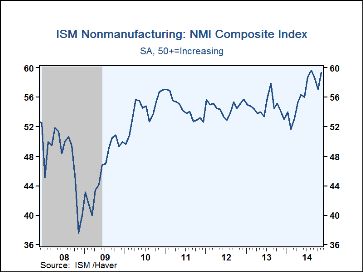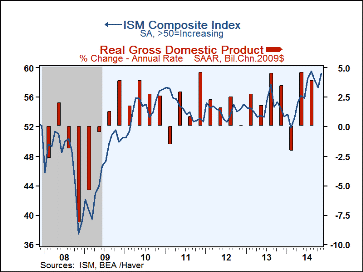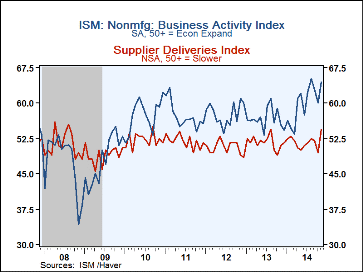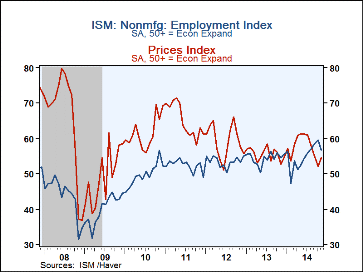 Global| Dec 03 2014
Global| Dec 03 2014U.S. ISM Nonmanufacturing Index Regains Strength
by:Tom Moeller
|in:Economy in Brief
Summary
Nonmanufacturing activity rebounded last month following two months of decline. The Institute for Supply Management's (ISM) composite nonmanufacturing index rose to 59.3 from 57.1 in October. The figure nearly reached its August peak [...]
Nonmanufacturing activity rebounded last month following two months of decline. The Institute for Supply Management's (ISM) composite nonmanufacturing index rose to 59.3 from 57.1 in October. The figure nearly reached its August peak and was just below the August 2005 high. This diffusion index indicates expansion of nonmanufacturing activity when above 50. Last month's figure exceeded expectations for 57.9 in the Action Economics Forecast Survey.
Haver Analytics calculates a composite index of factory sector activity (released Monday) plus nonmanufacturing activity. It improved to 59.2 in November and also was near the earlier highs. During the last ten years, there has been a 75% correlation between the index and the q/q change in real GDP.
Performance amongst the components was mostly positive last month. The business activity series rebounded to 64.4 after two months of decline. The new orders reading gained to 61.4 but failed to recover two months of decline. The vendor deliveries index jumped to 54.5, indicating the slowest delivery speeds since August of last year. Offsetting these gains was a decline in the employment figure to 56.7, off from the record high reached in October. During the last ten years, there has been a 92% correlation between the employment index and the m/m change in service plus construction payrolls.
The prices paid series rose following five straight months of decline. Fourteen percent of respondents paid higher prices, down from the 2011 high of 57%. Twelve percent paid lower prices, up from this year's low of 3%.
The ISM data are available in Haver's USECON database. The expectations figure from Action Economics is in the AS1REPNA database.
| ISM Nonmanufacturing Survey (SA) | Nov | Oct | Sep | Nov'13 | 2013 | 2012 | 2011 |
|---|---|---|---|---|---|---|---|
| Composite Diffusion Index | 59.3 | 57.1 | 58.6 | 54.1 | 54.7 | 54.6 | 54.4 |
| Business Activity | 64.4 | 60.0 | 62.9 | 55.3 | 56.7 | 57.7 | 57.2 |
| New Orders | 61.4 | 59.1 | 61.0 | 55.7 | 55.9 | 56.6 | 56.3 |
| Employment | 56.7 | 59.6 | 58.5 | 54.5 | 54.4 | 53.5 | 52.4 |
| Supplier Deliveries (NSA) | 54.5 | 49.5 | 52.0 | 51.0 | 51.7 | 50.6 | 51.9 |
| Prices Index | 54.4 | 52.1 | 55.2 | 52.7 | 55.6 | 59.3 | 65.1 |
Tom Moeller
AuthorMore in Author Profile »Prior to joining Haver Analytics in 2000, Mr. Moeller worked as the Economist at Chancellor Capital Management from 1985 to 1999. There, he developed comprehensive economic forecasts and interpreted economic data for equity and fixed income portfolio managers. Also at Chancellor, Mr. Moeller worked as an equity analyst and was responsible for researching and rating companies in the economically sensitive automobile and housing industries for investment in Chancellor’s equity portfolio. Prior to joining Chancellor, Mr. Moeller was an Economist at Citibank from 1979 to 1984. He also analyzed pricing behavior in the metals industry for the Council on Wage and Price Stability in Washington, D.C. In 1999, Mr. Moeller received the award for most accurate forecast from the Forecasters' Club of New York. From 1990 to 1992 he was President of the New York Association for Business Economists. Mr. Moeller earned an M.B.A. in Finance from Fordham University, where he graduated in 1987. He holds a Bachelor of Arts in Economics from George Washington University.










